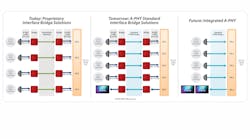The MIPI Alliance has released its MIPI A-PHY v1.0, said to be the first industry-standard, long-reach serializer-deserializer (SerDes) physical layer interface. The new specification, available to MIPI members, provides an asymmetric data link in a point-to-point topology, providing high-speed unidirectional data, embedded bidirectional control data and optional power delivery over a single cable.
A-PHY v1.0 offers:
- High reliability: Ultra-low packet error rate (PER) of 10-19 for unprecedented performance over the vehicle lifetime
- High resiliency: Ultra-high immunity to EMC effects in demanding automotive conditions
- Long reach: Up to 15 meters
- High performance: Data rate as high as 16 Gb/s with a roadmap to 48 Gb/s and beyond; v1.1, already in development, will provide a doubling of the high-speed data rate to 32 Gb/s and increase the uplink data rate to 200 Mb/s
In conjunction with the availability of A-PHY v1.0, the Alliance today introduced MIPI Automotive SerDes Solutions (MASS). MASS will provide automotive OEMs and their suppliers with end-to-end high-performance connectivity solutions for the growing number of cameras, sensors, and displays that enable automotive applications such as advanced driver-assistance systems (ADAS), connected in-vehicle infotainment (IVI), and, ultimately, fully autonomous vehicles. These solutions, with unprecedented functional safety and security built in at the protocol level, will help automakers integrate new and emerging safety features such as low-latency backup cameras, lane-keeping and sign-detection sensors and 360° camera, LiDAR, and radar systems. MASS also will support multiple high-resolution instrumentation, control and entertainment displays.
MASS protocol stack
As the physical layer cornerstone, A-PHY's primary mission is to transfer high-speed data between cameras and displays and their related domain ECUs. Through the development of additional supporting specifications, MASS will allow proven higher-layer protocols from MIPI (such as MIPI CSI-2 and DSI-2) and third parties to operate over physical links spanning an entire vehicle, eliminating the need for proprietary “bridges” and PHYs. For OEMs and system integrators this equates to simplified networks and reduced costs, weight and development time.
With A-PHY as the physical layer, the MASS protocol stack consists of:
- Higher-layer protocols such as MIPI CSI-2 and DSI-2, with updated versions to be available later this year and early 2021.
- Protocol adaptation layers (PALs) that map protocols to A-PHY's A-Packet format for transmission over A-PHY. PALs for MIPI CSI-2 and DSI-2, and for lower bandwidth interfaces such as I2C, I2S, GPIO, and Ethernet100, are expected to be completed later this year, and an I3C PAL can be expected in 2021. In addition, MIPI is working with other organizations to leverage additional established protocols. As one such effort, MIPI has extended its liaison with VESA and is actively developing an adaptation layer for use with its DisplayPort and Embedded DisplayPort standards.
- MIPI camera service extensions (CSE) and display service extensions (DSE) in development will add functional safety and security capabilities required for ADAS, self-driving and other applications, and will also provide high-bandwidth digital content protection (HDCP) as required for display applications.
MASS will address functional safety over heterogeneous protocols and numerous topologies, including daisy chaining, according to ISO 26262. System-level engineers can use this architecture to build systems that meet ASIL (Automotive Safety Integrity Level) requirements at any level, from ASIL B to ASIL D. MASS also will provide end-to-end security to include authentication, integrity and confidentiality for data protection of MASS camera, sensor and display components.
MIPI member companies participating in the A-PHY Subgroup include: Beijing ASL Technology Co., Ltd.; BitifEye Digital Test Solutions GmbH; Intel Corporation; Luxshare-ICT, Inc.; MediaTek Inc.; Mixel, Inc.; ON Semiconductor; Parade Technologies Ltd.; Primesoc Technologies; Prodigy Technovations Pvt. Ltd.; Qualcomm Incorporated; Robert Bosch GmbH; Sony Corporation; STMicroelectronics; Synopsys, Inc.; Tektronix, Inc.; Teledyne LeCroy; Toshiba Electronic Devices & Storage Corporation; Valens Semiconductor; and others.
MIPI Alliance, www.mipi.org

